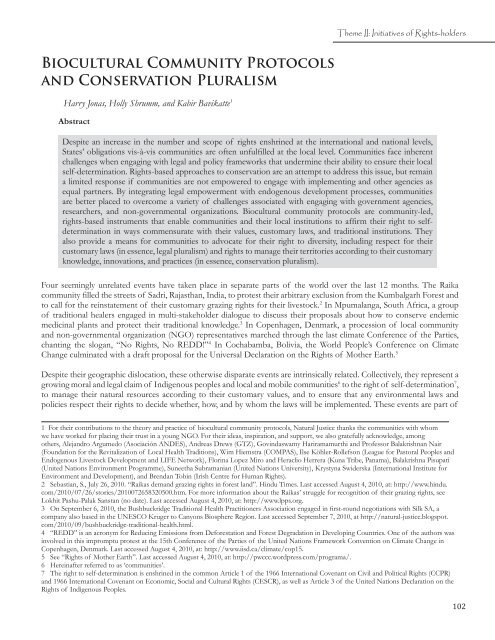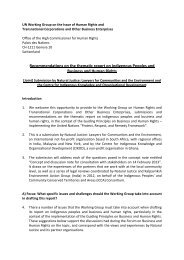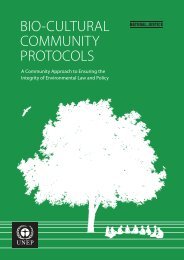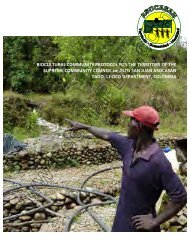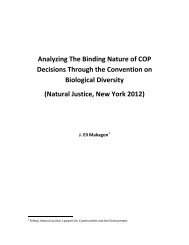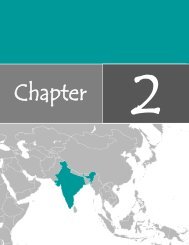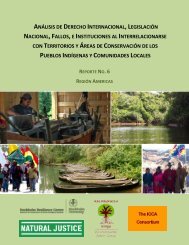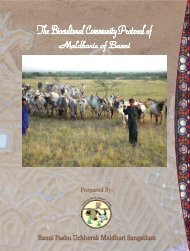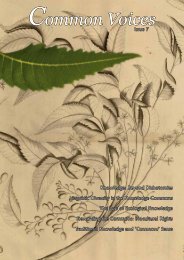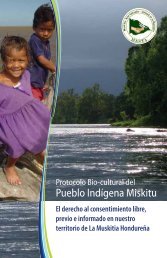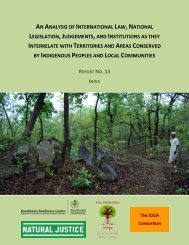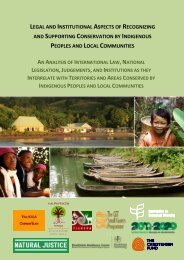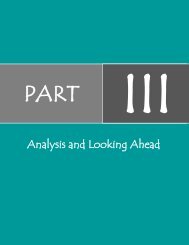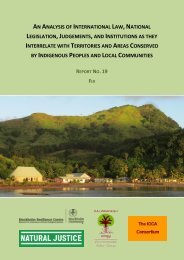Biocultural Community Protocols and Conservation ... - Natural Justice
Biocultural Community Protocols and Conservation ... - Natural Justice
Biocultural Community Protocols and Conservation ... - Natural Justice
- No tags were found...
Create successful ePaper yourself
Turn your PDF publications into a flip-book with our unique Google optimized e-Paper software.
Theme II: Initiatives of Rights-holders<strong>Biocultural</strong> <strong>Community</strong> <strong>Protocols</strong><strong>and</strong> <strong>Conservation</strong> PluralismHarry Jonas, Holly Shrumm, <strong>and</strong> Kabir Bavikatte 1AbstractDespite an increase in the number <strong>and</strong> scope of rights enshrined at the international <strong>and</strong> national levels,States’ obligations vis-à-vis communities are often unfulfilled at the local level. Communities face inherentchallenges when engaging with legal <strong>and</strong> policy frameworks that undermine their ability to ensure their localself-determination. Rights-based approaches to conservation are an attempt to address this issue, but remaina limited response if communities are not empowered to engage with implementing <strong>and</strong> other agencies asequal partners. By integrating legal empowerment with endogenous development processes, communitiesare better placed to overcome a variety of challenges associated with engaging with government agencies,researchers, <strong>and</strong> non-governmental organizations. <strong>Biocultural</strong> community protocols are community-led,rights-based instruments that enable communities <strong>and</strong> their local institutions to affirm their right to selfdeterminationin ways commensurate with their values, customary laws, <strong>and</strong> traditional institutions. Theyalso provide a means for communities to advocate for their right to diversity, including respect for theircustomary laws (in essence, legal pluralism) <strong>and</strong> rights to manage their territories according to their customaryknowledge, innovations, <strong>and</strong> practices (in essence, conservation pluralism).Four seemingly unrelated events have taken place in separate parts of the world over the last 12 months. The Raikacommunity filled the streets of Sadri, Rajasthan, India, to protest their arbitrary exclusion from the Kumbalgarh Forest <strong>and</strong>to call for the reinstatement of their customary grazing rights for their livestock. 2 In Mpumalanga, South Africa, a groupof traditional healers engaged in multi-stakeholder dialogue to discuss their proposals about how to conserve endemicmedicinal plants <strong>and</strong> protect their traditional knowledge. 3 In Copenhagen, Denmark, a procession of local community<strong>and</strong> non-governmental organization (NGO) representatives marched through the last climate Conference of the Parties,chanting the slogan, “No Rights, No REDD!” 4 In Cochabamba, Bolivia, the World People’s Conference on ClimateChange culminated with a draft proposal for the Universal Declaration on the Rights of Mother Earth. 5Despite their geographic dislocation, these otherwise disparate events are intrinsically related. Collectively, they represent agrowing moral <strong>and</strong> legal claim of Indigenous peoples <strong>and</strong> local <strong>and</strong> mobile communities 6 to the right of self-determination 7 ,to manage their natural resources according to their customary values, <strong>and</strong> to ensure that any environmental laws <strong>and</strong>policies respect their rights to decide whether, how, <strong>and</strong> by whom the laws will be implemented. These events are part of1 For their contributions to the theory <strong>and</strong> practice of biocultural community protocols, <strong>Natural</strong> <strong>Justice</strong> thanks the communities with whomwe have worked for placing their trust in a young NGO. For their ideas, inspiration, <strong>and</strong> support, we also gratefully acknowledge, amongothers, Alej<strong>and</strong>ro Argumedo (Asociación ANDES), Andreas Drews (GTZ), Govindaswamy Hariramamurthi <strong>and</strong> Professor Balakrishnan Nair(Foundation for the Revitalization of Local Health Traditions), Wim Hiemstra (COMPAS), Ilse Köhler-Rollefson (League for Pastoral Peoples <strong>and</strong>Endogenous Livestock Development <strong>and</strong> LIFE Network), Florina Lopez Miro <strong>and</strong> Heraclio Herrera (Kuna Tribe, Panama), Balakrishna Pisupati(United Nations Environment Programme), Suneetha Subramanian (United Nations University), Krystyna Swiderska (International Institute forEnvironment <strong>and</strong> Development), <strong>and</strong> Brendan Tobin (Irish Centre for Human Rights).2 Sebastian, S., July 26, 2010. “Raikas dem<strong>and</strong> grazing rights in forest l<strong>and</strong>”. Hindu Times. Last accessed August 4, 2010, at: http://www.hindu.com/2010/07/26/stories/2010072658320500.htm. For more information about the Raikas’ struggle for recognition of their grazing rights, seeLokhit Pashu-Palak Sanstan (no date). Last accessed August 4, 2010, at: http://www.lpps.org.3 On September 6, 2010, the Bushbuckridge Traditional Health Practitioners Association engaged in first-round negotiations with Silk SA, acompany also based in the UNESCO Kruger to Canyons Biosphere Region. Last accessed September 7, 2010, at http://natural-justice.blogspot.com/2010/09/bushbuckridge-traditional-health.html.4 “REDD” is an acronym for Reducing Emissions from Deforestation <strong>and</strong> Forest Degradation in Developing Countries. One of the authors wasinvolved in this impromptu protest at the 15th Conference of the Parties of the United Nations Framework Convention on Climate Change inCopenhagen, Denmark. Last accessed August 4, 2010, at: http://www.iisd.ca/climate/cop15.5 See “Rights of Mother Earth”. Last accessed August 4, 2010, at: http://pwccc.wordpress.com/programa/.6 Hereinafter referred to as ‘communities’.7 The right to self-determination is enshrined in the common Article 1 of the 1966 International Covenant on Civil <strong>and</strong> Political Rights (CCPR)<strong>and</strong> 1966 International Covenant on Economic, Social <strong>and</strong> Cultural Rights (CESCR), as well as Article 3 of the United Nations Declaration on theRights of Indigenous Peoples.102
Exploring the Right to Diversity in <strong>Conservation</strong> Law, Policy, <strong>and</strong> Practicea global movement 8 calling for alternatives to the dominant development model, the latter of which has neither banishedpoverty nor solved world hunger, but continues to drive widespread biodiversity loss <strong>and</strong> climate change. 9 The events alsohighlight two critical sites of struggle towards a new conservation paradigm: at the national <strong>and</strong> international legislative <strong>and</strong>policy-making level, where positive laws are made, <strong>and</strong> at the community level, where the law is implemented.International Rights <strong>and</strong> Local WrongsTwo major international environmental legal instruments are currently being negotiated under the auspices of theirrespective United Nations (UN) Conventions that will have far-reaching implications for communities: the (Nagoya)Protocol on Access <strong>and</strong> Benefit Sharing (ABS) 10 <strong>and</strong> the programme on Reducing Emissions from Deforestation <strong>and</strong>Forest Degradation in Developing Countries (REDD). 11 Communities are struggling to fully <strong>and</strong> effectively participatein both sets of negotiations to ensure that the consequent international instruments provideInternational rightsare far from apanacea against localdisempowerment or thedenial of procedural<strong>and</strong> substantive justice.communities with critical safeguards such as the right to free, prior <strong>and</strong> informed consent toany activities that take place on their territories or will affect their ways of life.Ensuring that communities’ rights are enshrined in international <strong>and</strong> national laws is ofparamount importance to ensuring respect <strong>and</strong> support for biocultural diversity 12 at thelocal level. As such, communities <strong>and</strong> their representatives are compelled to engage with thenegotiations of multilateral environmental agreements <strong>and</strong> their protocols <strong>and</strong> other softlawinstruments. Yet the harsh paradox is that even when hard-fought negotiations result incommunities’ rights being enshrined in law, their local effects are often muted because of thecomplex socio-political contexts within which communities live. 13 For example, Linda Siegele et al. detail a plethora of rightsrelating to communities across a range of hard <strong>and</strong> soft law instruments. 14 Their exhaustive review, including multilateralenvironmental agreements, human rights instruments, UN agencies’ policy documents, <strong>and</strong> International Union for<strong>Conservation</strong> of Nature (IUCN) resolutions, illustrates the scale of communities’ rights agreed at the international level.However, their telling conclusion is that “good policy is just a starting point – good practice is more difficult to achieve.” 15Similarly, Lorenzo Cotula <strong>and</strong> James Mayers highlight the gap between what is “on paper” <strong>and</strong> what happens in practicein the context of local l<strong>and</strong> tenure <strong>and</strong> REDD projects 16 . They underscore the fact that despite a growing internationalrecognition of communities’ rights to self-determine their futures <strong>and</strong> manage their natural resources, 17 international rightsare far from a panacea against local disempowerment or the denial of procedural <strong>and</strong> substantive justice.In efforts to secure their rights over natural resources <strong>and</strong> traditional knowledge <strong>and</strong> protect their ways of life, communitiescontinue the international struggle for the recognition of their rights across a number of legislative <strong>and</strong> policy frameworks. 188 Escobar, A., 1998. “Whose Knowledge, Whose Nature? Biodiversity, <strong>Conservation</strong> <strong>and</strong> the Political Economy of Social Movements”. Journal ofPolitical Ecology, 5: 53-82.9 Secretariat of the Convention on Biological Diversity, 2010. Global Biodiversity Outlook 3. Secretariat of the Convention on Biological Diversity:Montreal, Canada.10 The Protocol on ABS is expected to be adopted at the 10 th Conference of the Parties of the United Nations Convention on BiologicalDiversity from October 18-29, 2010, in Nagoya, Japan. For more information, see Tobin, B., 2010. “‘The Law Giveth <strong>and</strong> the Law Taketh Away’:The Case for Recognition of Customary Law in International ABS <strong>and</strong> Traditional Knowledge Governance”, pages 16-25 in this issue of PolicyMatters.11 REDD is expected to be further discussed at the 16 th Conference of the Parties of the United Nations Framework Convention on ClimateChange from November 29-December 10, 2010, in Cancún, Mexico. For more information, see Lovera, S., 2010. “Rights <strong>and</strong> REDD: Can They BeMatched?”, pages 40-47 in this issue of Policy Matters.12 Maffi, L., <strong>and</strong> E. Woodley, 2010. <strong>Biocultural</strong> Diversity <strong>Conservation</strong>: A Global Sourcebook. Earthscan: UK.13 For example, see Nelson, F., 2010. “<strong>Conservation</strong> <strong>and</strong> Citizenship: Democratizing <strong>Natural</strong> Resource Governance in Africa”, pages 233-241 inthis issue of Policy Matters.14 Siegele, L., D. Roe, A. Giuliani, <strong>and</strong> N. Winer, 2009. “<strong>Conservation</strong> <strong>and</strong> Human Rights, Who Says What?”, pages 47-76 in Campese, J., T.Sunderl<strong>and</strong>, T. Greiber, <strong>and</strong> G. Oviedo (eds.), Rights-based Approaches: Exploring Issues <strong>and</strong> Opportunities for <strong>Conservation</strong>. CIFOR <strong>and</strong> IUCN: Bogor,Indonesia.15 Siegele et al., 2009, page 69.16 Cotula, L., <strong>and</strong> J. Mayers, 2009. Tenure in REDD – Start-point or afterthought? <strong>Natural</strong> Resource Issues No. 15. International Institute forEnvironment <strong>and</strong> Development (IIED): London, UK, page 23.17 For example, see Morel, C., 2010. “Communication 276 / 2003 – Centre for Minority Rights Development (Kenya) <strong>and</strong> Minority Rights GroupInternational on behalf of Endorois Welfare Council v. Kenya”. Housing <strong>and</strong> ESC Rights Law Quarterly, 7(1). Last accessed July 14, 2010, at: http://www.cohre.org; <strong>and</strong> Morel, C., 2010. “<strong>Conservation</strong> <strong>and</strong> Indigenous Peoples’ Rights: Must One Necessarily Come at the Expense of the Other?”,pages 174-181 in this issue of Policy Matters.18 For example, see the latest round of the Interregional Negotiating Group of the Ad Hoc Open-ended Working Group on Access <strong>and</strong> BenefitSharing, held September 18-21, 2010, in Montreal. Last accessed September 22, 2010, at: http://www.iisd.ca/biodiv/absing.103Policy Matters 17, 2010
Theme II: Initiatives of Rights-holdersHowever, international advocacy must be augmented by the improvedexercise of rights at the local level. There is a legal maxim that there isno right without a remedy 19 ; equally, an international right without localeffect is no right at all. Before addressing legal empowerment <strong>and</strong> rightsbasedapproaches to conservation, a critique of positive (national <strong>and</strong>international) law from the community perspective illustrates certaininherent challenges.<strong>Biocultural</strong> Diversity <strong>and</strong> the LawIndigenous peoples’ <strong>and</strong> local <strong>and</strong> mobile communities’ diversity ofworldviews, cultures, <strong>and</strong> ways of life are helping to conserve <strong>and</strong>sustainably use the world’s biological diversity. 20 Biological diversity cannotbe seen as separate from cultural <strong>and</strong> linguistic diversity, as “the diversityof life in all its manifestations … are interrelated (<strong>and</strong> likely co-evolved)within a complex socio-ecological adaptive system.” 21 The multiplicityof interrelated knowledge, innovations, practices, values, <strong>and</strong> customarylaws 22 are embedded within mutually supporting relationships betweenl<strong>and</strong>, natural resource use, culture, <strong>and</strong> spirituality. 23 This connectivityunderpins communities’ dynamic worldviews <strong>and</strong> underst<strong>and</strong>ings of thelaws of nature. 24Figure 1. The livelihoods of Samburupastoralists in Kenya are inextricably based on theinterlinkages between their livestock, culture, <strong>and</strong>local biodiversity. © Harry JonasWithin this context, communities face a number of inter-related challenges when engaging with positive (State) legalsystems. Three in particular have ramifications for communities seeking to assert their rights to self-determination <strong>and</strong>The multiplicity ofcommunities’ traditions<strong>and</strong> values that areembedded within l<strong>and</strong>,resource use, <strong>and</strong>culture underpins theirunderst<strong>and</strong>ings of thelaws of nature.well-being. First, laws compartmentalize the otherwise interdependent aspects of bioculturaldiversity by drawing legislative borders around them <strong>and</strong> addressing them as distinct segments.While communities manage integrated l<strong>and</strong>scapes, 25 the State tends to view each resource <strong>and</strong>associated traditional knowledge through a narrow lens, implementing corresponding lawsthrough agencies that separately address, for example, biodiversity, forests, agriculture, <strong>and</strong>Indigenous knowledge systems. 26 The result is that communities’ lives are disaggregated in law<strong>and</strong> policy, which effectively fragments their claims to self-determination into specific issuerelatedsites of struggle.In addition to the challenge of legal fragmentation, the law affects the very nature of whomor what is defined as ‘community’. In general, people have a variety of ways of establishingwho is a member of a family or community <strong>and</strong> who is an outsider. Communities may define19 This maxim is written in Latin as Ubi jus ibi remedium. Constitution Society, 2009. “Principles of Constitutional Construction”. Last accessedAugust 4, 2010, at: http://www.constitution.org/cons/prin_cons.htm.20 Maffi <strong>and</strong> Woodley, 2010.21 Maffi, L., 2010. “What is <strong>Biocultural</strong> Diversity”, pages 3-12 in Maffi <strong>and</strong> Woodley, 2010, page 5.22 This is also referred to as ‘collective biocultural heritage’, which is the knowledge, innovations, <strong>and</strong> practices of Indigenous peoples <strong>and</strong>local <strong>and</strong> mobile communities that are “collectively held <strong>and</strong> inextricably linked to traditional resources <strong>and</strong> territories, local economies, thediversity of genes, varieties, species <strong>and</strong> ecosystems, cultural <strong>and</strong> spiritual values, <strong>and</strong> customary laws shaped within the socio-ecological contextof communities.” This definition was developed at a workshop of research <strong>and</strong> Indigenous partners of the project on Traditional KnowledgeProtection <strong>and</strong> Customary Law that was held in Peru in May, 2005. See Swiderska, K., 2006. Banishing the Biopirates: A New Approach to ProtectingTraditional Knowledge, Gatekeeper Series 129. IIED: London. Also see IIED, 2010. “Protecting community rights over traditional knowledge”. Lastaccessed August 24, 2010, at: http://www.iied.org/natural-resources/key-issues/biodiversity-<strong>and</strong>-conservation/protecting-community-rights-overtraditio.23 See, for example, Descola, P., 1992. “Society of Nature <strong>and</strong> the Nature of Society”, pages 107-157 in Kuper, A. (ed.), Conceptualizing Society.European Association of Social Anthropologists, Routledge: London.24 See, for example, Davidson-Hunt, I., <strong>and</strong> F. Berkes, 2003. “Learning as You Journey: Anishinaabe Perception of Social-ecologicalEnvironments <strong>and</strong> Adaptive Learning”. <strong>Conservation</strong> Ecology, 8(1): 5-26; <strong>and</strong> Alex<strong>and</strong>er, M., P. Hardinson, <strong>and</strong> M. Arhen, 2009. Study on Compliance inRelation to the Customary Law of Indigenous <strong>and</strong> Local Communities, National Law, Across Jurisdictions, <strong>and</strong> International Law, CBD Information Document preparedfor the 7 th Meeting of the Ad Hoc Open-ended working Group on Access <strong>and</strong> Benefit Sharing. UNEP/CBD/WG-ABS/7/INF/5, page 9.25 Watson, A., L. Alessa, <strong>and</strong> B. Glaspell, 2003. “The Relationship Between Traditional Ecological Knowledge, Evolving Cultures, <strong>and</strong> WildernessProtection in the Circumpolar North”. <strong>Conservation</strong> Ecology, 8(1): 2-15.26 In South Africa, for example, the Department of Environmental Affairs has a m<strong>and</strong>ate to manage the country’s biodiversity, but they shareresponsibility to protect communities’ associated traditional knowledge with the Department of Science <strong>and</strong> Technology.104
Exploring the Right to Diversity in <strong>Conservation</strong> Law, Policy, <strong>and</strong> Practicethemselves in a number of different ways <strong>and</strong> in different contexts, based on multiple factors such as heritage, ethnicity,language, geographical proximity, <strong>and</strong> shared resources or knowledge. 27 State law, however, is insensitive to local, adaptiveconceptions of community <strong>and</strong> tends to impose an over-generalized <strong>and</strong> homogeneous classification as a static <strong>and</strong> rigidlydefined entity. This contradicts local realities <strong>and</strong> can further divide <strong>and</strong> weaken local institutions <strong>and</strong> social structures. 28The disaggregationof communities’ livesthrough law <strong>and</strong> policyfragments their claimsto self-determinationinto issue-specific sitesof struggle.However, this challenge can be overcome by using the law as the basis for adding a newdimension to local constructions of community that progresses the right to self-determination.For example, in Bushbuckridge, South Africa, a group of traditional healers spread across alarge number of villages <strong>and</strong> from two different language groups came together to definethemselves as a community of knowledge holders 29 in the context of new rights providedunder South African ABS law. 30 Although this type of law tends to place a disproportionateemphasis on the sharing of traditional knowledge as the means by which to characterize acommunity 31 , the Bushbuckridge Traditional Health Practitioners are using its provisions tocreate <strong>and</strong> occupy a new legal space, within which they are asserting their rights to traditionalknowledge <strong>and</strong> customary practices. All communities are dynamic <strong>and</strong> issues of self-definition<strong>and</strong> fluid identity are neither new to traditional communities nor inherently destructive to theirsocial structures. The critical determinant is whether they are able to engage adequately with legal <strong>and</strong> policy processes toavoid potential negative impacts of change <strong>and</strong> drive positive developments according to their own values <strong>and</strong> priorities. 32As a third <strong>and</strong> cross-cutting challenge inherent to engaging with legal frameworks, positive law (both international <strong>and</strong>State) may conflict with the customary laws that govern communities’ sustainable use of natural resources. 33 For example,the underst<strong>and</strong>ing of ‘property’ under positive law is based on the private rights of a person(human or corporate) to appropriate <strong>and</strong> alienate physical <strong>and</strong> intellectual property. In contrast,communities’ property systems tend to emphasize relational <strong>and</strong> collective values of resources. 34Furthermore, the implementation of positive law tends to overpower <strong>and</strong> contravene customarylaw. A system that denies legal pluralism 35 has direct impacts on communities’ lives, for example,by undermining the cultural practices <strong>and</strong> institutions that underpin sustainable ecosystemmanagement. 36 While recognition of communities’ customary laws <strong>and</strong> traditional authority overresources is progressing in some jurisdictions, 37 the challenge of legal pluralism goes beyondthe mere co-existence of legal regimes, wherein customary law is applicable only to Indigenouspeoples within their territories. Instead, meaningful legal pluralism requires “incorporationdirectly or indirectly of principles, measures <strong>and</strong> mechanisms drawn from customary law withinnational <strong>and</strong> international legal regimes for the protection of traditional knowledge.” 38Legal pluralism goesbeyond the mere coexistenceof legalregimes <strong>and</strong> requiresthe incorporation ofaspects of customarylaw into national <strong>and</strong>international law.27 Agrawal, A., <strong>and</strong> C. C. Gibson, 1999. “Enchantment <strong>and</strong> Disenchantment: The Role of <strong>Community</strong> in <strong>Natural</strong> Resource <strong>Conservation</strong>”. WorldDevelopment, 27(4): 629-649.28 Bosch, D., 2003. “L<strong>and</strong> Conflict Management in South Africa: Lessons Learned from a L<strong>and</strong> Rights Approach”. Last accessed August 4, 2010,at: http://www.fao.org/docrep/006/j0415t/j0415t0a.htm.29 For more information about the Traditional Health Practitioners of Bushbuckridge, including a copy of their biocultural community protocol,see <strong>Natural</strong> <strong>Justice</strong>, 2010. Last accessed August 4, 2010, at: http://www.naturaljustice.org.30 Bioprospecting, Access <strong>and</strong> Benefit Sharing Rules, 2008. Government Gazette No. 30739, February 8, 2008. Department of EnvironmentalAffairs <strong>and</strong> Tourism, Pretoria, South Africa.31 For example, the San <strong>and</strong> Nama in Southern Africa share ethnobotanical knowledge of the Hoodia succulent. See Bavikatte, K., H. Jonas,<strong>and</strong> J. von Braun, 2009. “Shifting S<strong>and</strong>s of ABS Best Practice: Hoodia from the <strong>Community</strong> Perspective”. United Nations University TraditionalKnowledge Initiative. Last accessed August 4, 2010, at: http://www.unutki.org/default.php?doc_id=137.32 Cotula, L., <strong>and</strong> P. Mathieu (eds.), 2008. Legal Empowerment in Practice, Using Legal Tools to Secure L<strong>and</strong> Rights in Africa. IIED: London, page 10.33 Cotula <strong>and</strong> Mathieu, 2008, page 11.34 Tobin, B., <strong>and</strong> E. Taylor 2009. “Across the Great Divide: A Case Study of Complementarity <strong>and</strong> Conflict Between Customary Law <strong>and</strong> TKProtection Legislation in Peru”. Initiative for the Prevention of Biopiracy, Year IV: 11, page 10. Such systems have been described as “...commonlycharacterized by collective ownership (where the community owns a resource, but individuals may acquire superior rights to or responsibilitiesfor collective property), <strong>and</strong> communal ownership (where the property is indivisibly owned by the community).” See Tsosie, R., 2007. “Culturalchallenges to biotechnology: Native American cultural resources <strong>and</strong> the concept of cultural harm”. Journal of Law, Medicine & Ethics, 35: 396, citedin Tobin <strong>and</strong> Taylor, 2009, page 36.35 This type of system could be referred to as legal monoculture.36 Sheleef, L., 2000. The Future of Tradition: Customary Law, Common Law <strong>and</strong> Legal Pluralism. Frank Cass: London, Engl<strong>and</strong>, <strong>and</strong> Portl<strong>and</strong>, Oregon.37 Van Cott, D., 2000. “A Political Analysis of Legal Pluralism in Bolivia <strong>and</strong> Colombia”. Journal of Latin American Studies, 32: 207-234.38 Tobin, B., 2009. “Setting Traditional Knowledge Protection to Rights: Placing Human Rights <strong>and</strong> Customary Law at the Center of TraditionalKnowledge Governance”, pages 101-115 in Kamau, E., <strong>and</strong> G. Winer (eds.), Genetic Resources, Traditional Knowledge <strong>and</strong> the Law. Solutions for Access<strong>and</strong> Benefit Sharing. Earthscan: UK, page 111. This is arguably a huge challenge <strong>and</strong> most States are a long way from incorporating Indigenousworldviews into legal <strong>and</strong> policy frameworks.105Policy Matters 17, 2010
Theme II: Initiatives of Rights-holdersThese three challenges, among others, highlight the fact that the imposition of international <strong>and</strong> national environmentallaws, which are inherently fragmentary <strong>and</strong> based on static misperceptions of local realities, has the potential to underminethe interconnected <strong>and</strong> adaptive systems that underpin biocultural diversity. The implementation of such laws compoundsthese challenges by requiring communities to engage with disparate stakeholders 39 according to a variety of disconnectedregulatory frameworks, many of which may conflict with their customary laws <strong>and</strong>traditional governance structures. Communities thus face a stark choice to eitherspurn these inherently limited frameworks (something which is a virtual impossibilityconsidering the ubiquitous nature of State law) or engage with them at the potentialexpense of becoming complicit in the disaggregation of their otherwise holistic waysof life <strong>and</strong> governance systems. If the latter is chosen, the resultant challenge is forcommunities to draw upon <strong>and</strong> further develop appropriate means to effectively engagewith State <strong>and</strong> international legal <strong>and</strong> policy frameworks, specifically in ways thataccord with their biocultural heritage, support their integrated systems of ecosystemmanagement, are commensurate with their customary laws, <strong>and</strong> recognize traditionalforms of governance. In the absence of such approaches, the very act of using rightscan be disempowering <strong>and</strong> disenfranchising. 40Rights-based Approaches <strong>and</strong> Pluralism in<strong>Conservation</strong>Rights-based approaches are being promoted as a means to ensure that conservationpolicy <strong>and</strong> practice support communities’ rights to self-determination <strong>and</strong> wellbeing41 <strong>and</strong> promote social, cultural, <strong>and</strong> environmental justice. 42 Such approaches aredescribed as “integrating rights norms, st<strong>and</strong>ards, <strong>and</strong> principles into policy, planning,implementation, <strong>and</strong> outcomes assessment to help ensure that conservation practicerespects rights in all cases, <strong>and</strong> supports their further realization where possible.” 43They are based on the principle that communities are not merely stakeholders whoseviews governmental <strong>and</strong> conservation agencies may take into account, but are rightsholdersto whom implementing agencies have statutory obligations. In addition, everyright is accompanied by responsibilities <strong>and</strong> duties to the self <strong>and</strong> to other individuals<strong>and</strong> collectives. 44 Communities may take this principle even further by acknowledgingtheir duties to specific plants, totemic animals, or all of Mother Earth. 45 Rights-basedFigure 2. Gunis (traditional healers)in Rajasthan have cultural <strong>and</strong>spiritual values <strong>and</strong> duties thatunderpin their use of medicinalplants <strong>and</strong> the sharing of theirknowledge. © Harry Jonasapproaches must thus acknowledge not only the rights of all parties (including communities) under both positive <strong>and</strong>customary law, but also their duties. 46 Such an underst<strong>and</strong>ing of the fundamental nature of rights ensures that rights-basedapproaches to conservation are not simply defensive dem<strong>and</strong>s by marginalized groups, but are commitments to workconstructively towards consensus on the basis of mutual recognition of parties’ respective rights <strong>and</strong> duties.The integrity 47 of rights-based approaches must be ensured both within institutions <strong>and</strong> within communities. At the39 Examples include government agencies, conservation <strong>and</strong> development NGOs, private sector companies, <strong>and</strong> researchers.40 This is also supported by anecdotal evidence by public interest lawyers such as Fatima Hassan (former senior attorney, AIDS Law Project,South Africa) who argues that even when ordinary people do use the law <strong>and</strong> engage legal systems, the process is often both disempoweringbecause of the asymmetrical “lawyer-client” relationship <strong>and</strong> dehumanizing because of the Kafkaesque nature of legal proceedings.41 Reflecting Principle 1 of the Declaration of the United Nations Conference on the Human Environment (Stockholm, June 16, 1972): “Manhas the fundamental right to freedom, equality <strong>and</strong> adequate conditions of life, in an environment of a quality that permits a life of dignity <strong>and</strong>well-being”. Last accessed August 4, 2010, at: http://www.unep.org/Documents.Multilingual/Default.asp?documentid=97&articleid=1503.42 Notably, the environmental justice movement represents “an integration of civil rights <strong>and</strong> environmental laws that may aptly be described as aquest for environmental civil rights.” Roberts, R. G., 1999. “Environmental <strong>Justice</strong> <strong>and</strong> <strong>Community</strong> Empowerment, Learning from the Civil RightsMovement”. American University Law Review, 48: 229-260, page 232. Also see Greiber, T. (ed.), 2009. <strong>Conservation</strong> with <strong>Justice</strong>: A Rights-Based Approach.IUCN: Gl<strong>and</strong>, Switzerl<strong>and</strong>, page 2.43 Campese, J., T. Sunderl<strong>and</strong>, T. Greiber, <strong>and</strong> G. Oviedo (eds.), 2009. Rights-based approaches: Exploring Issues <strong>and</strong> Opportunities for <strong>Conservation</strong>. CIFOR<strong>and</strong> IUCN: Bogor, Indonesia, page 8.44 In her seminal World War II-era work, Simone Weil argues that rights only exist in relation to corresponding duties <strong>and</strong> obligations, whichtranscend the world of competing interests in the pursuit of justice. See Weil, S., 2001. The Need for Roots: Prelude to a Declaration of Duties TowardsMankind, 2 nd edition. Routledge Classics: UK.45 Martin, J., <strong>and</strong> E. Inns, 2010. “Totem poles as a representation of natural law of Indigenous peoples of Clayoquot Sound”. EndogenousDevelopment Magazine, 6: 15.46 This may be described as a duties-based approach.47 For an in-depth discussion of the concept of integrity as it applies to the environment <strong>and</strong> justice, see Westra, L., 2005. “Ecological Integrity”,106
Exploring the Right to Diversity in <strong>Conservation</strong> Law, Policy, <strong>and</strong> Practiceinstitutional level, implementing agencies must improve their underst<strong>and</strong>ing of communities’ rights <strong>and</strong> duties <strong>and</strong> instatemeasures to ensure that their actions accord with the st<strong>and</strong>ards <strong>and</strong> procedures established by customary, national, <strong>and</strong>international laws. The <strong>Conservation</strong> Initiative on Human Rights (CIHR) is a good example of the institutional changethat is being undertaken by a consortium of international conservation NGOs that seek to improve the practice ofconservation through the integration of human rights. 48 The commitment shown by these organizations is commendable<strong>and</strong> necessary, but constitutes only part of the multifaceted approach that is required toenact institutional change in policy <strong>and</strong> practice. The ability of communities to engage asequals in the implementation of environmental laws is also critically important, <strong>and</strong> legalempowerment is one contributing factor to this transformation. 49The need for legal empowerment in the context of rights-based approaches can beillustrated with reference to the IUCN Environmental Law Centre’s stepwise approach. 50This graduated method encourages implementing agencies to ensure that any measuresundertaken towards conservation <strong>and</strong> climate change mitigation are in accordance withstakeholders’ rights by following five steps, namely: undertaking a situation analysis;providing information; ensuring participation; taking reasoned decisions; <strong>and</strong> monitoring<strong>and</strong> evaluating the implementation of the rights-based approach. The approach providesclear guidance to implementing agencies, but arguably risks being considered a replacementfor the independent empowerment of communities.Rights-based approachesare not simply defensivedem<strong>and</strong>s, but constructivecommitments to worktowards consensus on thebasis of mutual recognitionof parties’ respective rights<strong>and</strong> duties.For example, Element 2 of the Convention on Biological Diversity’s Programme of Work on Protected Areas (PoWPA),which addresses governance, participation, equity, <strong>and</strong> benefit sharing, establishes procedural <strong>and</strong> substantive st<strong>and</strong>ards forStates to involve communities in protected areas. Parties are called on, inter alia, to “effectively involve indigenous <strong>and</strong> localcommunities, with respect for their rights consistent with national legislation <strong>and</strong> applicable international obligations, <strong>and</strong> stakeholders atall levels of protected areas planning, establishment, governance <strong>and</strong> management, with particular emphasis on identifying<strong>and</strong> removing barriers preventing adequate participation.” 51 PoWPA’s reference to ‘effective’ involvement, like IUCN’semphasis on ‘ensuring’ participation, is a subjective term influenced by complex political <strong>and</strong> social dynamics at the State<strong>and</strong> local level. 52 Full <strong>and</strong> effective involvement <strong>and</strong> participation are not just rights to be ensured by top-down processes,but are also contingent upon empowered communities engaging with implementing agencies as equal but distinct partners.Similarly, IUCN’s stipulation that communities are provided information (the lack of which is one of the “barrierspreventing adequate participation” noted by PoWPA Activity 2.2.2.) is important, but not as meaningful as communitiesknowing which information to ask for, obtaining it, <strong>and</strong> conducting their own processes to formulate <strong>and</strong> assert theirviews about <strong>and</strong> involvement in any proposed protected area. The oft-cited right of communities to provide free, prior<strong>and</strong> informed consent 53 must also entail the right to refuse to provide such consent; only then could their subsequentinvolvement in the governance <strong>and</strong> management of protected areas have local integrity.Towards the goal of improving equity <strong>and</strong> benefit sharing, PoWPA also calls on Parties to establish “policies <strong>and</strong>institutional mechanisms with full participation of indigenous <strong>and</strong> local communities, to facilitate the legal recognitionpages 574-578 in Mitcham, C. (ed.), Encyclopedia of Science, Technology, <strong>and</strong> Ethics, Volume 2. Macmillan Reference USA: Detroit.48 CIHR partner organizations include BirdLife International, <strong>Conservation</strong> International, Fauna & Flora International, IUCN, The NatureConservancy, Wetl<strong>and</strong>s International, the Wildlife <strong>Conservation</strong> Society, <strong>and</strong> the World Wide Fund for Nature. See Roe, D., G. Oviedo, L. Pabon,M. Painter, K. Redford, L. Siegele, J. Springer, D. Thomas, <strong>and</strong> K. Walker Painemilla, 2010. <strong>Conservation</strong> <strong>and</strong> Human Rights: The Need for InternationalSt<strong>and</strong>ards. IIED: London, United Kingdom; <strong>and</strong> Springer, J., J. Gastelumendi, G. Oviedo, K. Walker Painemilla, M. Painter, K. Seesink, H. Schneider,<strong>and</strong> D. Thomas, 2010. “The <strong>Conservation</strong> Initiative on Human Rights: Promoting Increased Integration of Human Rights in <strong>Conservation</strong>”, pages81-83 in this issue of Policy Matters.49 Without corresponding legal empowerment, rights-based approaches will fall foul of the same criticisms that Stephen Golub made of rule oflaw programmes in the 1990s, which he characterized as privileging judicial reform (“the power of the lawyers”) over improving access to justice(“the power of the people”). Golub, S., 2003. Beyond Rule of Law Orthodoxy: The Legal Empowerment Alternative, Rule of Law Series, Number 41.Carnegie Endowment for International Peace: Washington, D. C., page 3.50 Shelton, D., 2009. “A Rights-based Approach to <strong>Conservation</strong>”, pages 5-36 in Greiber, 2009.51 Convention on Biological Diversity, Programme of Work on Protected Areas, Activity 2.2.2 (emphasis added). Last accessed August 4, 2010, at:http://www.cbd.int/protected/pow/learnmore/intro/?prog=p2.52 For example, see Madzwamuse, M., 2010. “Rights-based Approaches to <strong>Conservation</strong> in Protected Areas: What are the Issues for SouthernAfrica?”, pages 223-227 in this issue of Policy Matters.53 This right is enshrined in Articles 10, 11(2), 19, 28, 29(2), <strong>and</strong> 32(2) of the United Nations Declaration on the Rights of Indigenous Peoples,2007. General Assembly Resolution 61/295. Also see Colchester, M., <strong>and</strong> M. Farhan Ferrari, 2007. Making FPIC Work: Challenges <strong>and</strong> Prospects forIndigenous Peoples. Forest Peoples Programme: United Kingdom.107Policy Matters 17, 2010
<strong>and</strong> effective management of indigenous <strong>and</strong> local community conserved areas in a mannerconsistent with the goals of conserving both biodiversity <strong>and</strong> the knowledge, innovations<strong>and</strong> practices of indigenous <strong>and</strong> local communities.” 54 With reference to the discussionabove on legal pluralism, Element 2 of PoWPA underscores the need for implementingagencies to recognize <strong>and</strong> support the right to conservation pluralism – the diversity ofcommunity-based approaches to the conservation <strong>and</strong> sustainable <strong>and</strong> customary use ofbiodiversity.Legal Empowerment <strong>and</strong> Endogenous DevelopmentParticipatory legal empowerment will further enable communities to gain recognitionof <strong>and</strong> support for the plurality of approaches to conservation law, policy, <strong>and</strong> practice.Legal empowerment is defined as “the use of legal tools to tackle power asymmetries <strong>and</strong>help disadvantaged groups have greater control over decisions <strong>and</strong> processes that affecttheir lives.” 55 Evidence suggests that non-lawyers are equally equipped to use the law (<strong>and</strong>sometimes more adept at doing so) to solve local challenges when they are empowered ina legal context. 56 Legal empowerment of the poor 57 is based on the twin principles thatlaw should not remain a monopoly of trained professionals <strong>and</strong> that in many instances,forms of alternative dispute resolution are more attuned to local realities than formal legalprocesses. Ideally, the act of using the law becomes as empowering as the outcome of theprocess itself. 58 By organizing themselves around rights <strong>and</strong> duties, communities initiateadaptive dialogue processes both internally <strong>and</strong> vis-à-vis outsiders. Building internalEffective legalempowerment is acombination of socialmobilization <strong>and</strong> legalaction that acts as apositive feedback looptowards both aims.resilience to external influences <strong>and</strong> responding proactively<strong>and</strong> according to local values <strong>and</strong> priorities are both criticalto a community’s well-being. 59 A court victory h<strong>and</strong>ed to acommunity, for example, can be supremely useful, but aprocess that is driven by the community is tangibly morepowerful. 60 As such, effective legal empowerment is aTheme II: Initiatives of Rights-holdersFigure 3. The law can be usedto tackle power asymmetries<strong>and</strong> build community resilience<strong>and</strong> well-being.© Holly Shrummcombination of social mobilization <strong>and</strong> legal action 61 that acts as a positive feedback looptowards both aims.The law is sometimes described as ‘a sword <strong>and</strong> a shield’. 62 Negotiating in the shadow of thelaw 63 is an important strategy for communities who might otherwise not have the opportunityto engage with conservation policy <strong>and</strong> practice. However, law is about more than just establishing due process. When usedimaginatively, laws can be the platform for creating an enabling legal <strong>and</strong> political environment by negotiating “space toplace new steps of change” 64 <strong>and</strong> opening avenues of discussion between disparate groups towards previously unimaginedrelationships. 65 In this sense, legal empowerment can enable communities to break free from the typical patronizing54 Convention on Biological Diversity, Programme of Work on Protected Areas, Activity 2.1.3 (emphasis added). Last accessed August 4, 2010, at:http://www.cbd.int/protected/pow/learnmore/intro/?prog=p2.55 Cotula <strong>and</strong> Mathieu, 2008, page 15.56 Maru, V., 2006. “Between Law <strong>and</strong> Society: Paralegals <strong>and</strong> the Provision of <strong>Justice</strong> Services in Sierra Leone <strong>and</strong> Worldwide”. The Yale Journal ofInternational Law, 31: 427-476.57 This is a reference to the United Nations Development Programme, 2010. “Initiative on Legal Empowerment of the Poor”. Last accessedAugust 4, 2010, at: http://www.undp.org/legalempowerment/.58 Maru, 2006.59 Subramanian, S. M., <strong>and</strong> B. Pisupati, 2009. Learning from the Practitioners: Benefit Sharing Perspectives form Enterprising Communities. UNEP <strong>and</strong> UNUniversity: Nairobi.60 “The most valuable, useful <strong>and</strong> transformative legal challenges are those that include communities <strong>and</strong> that mobilize <strong>and</strong> educate people so thatcommunities use the law to give effect to their own voices <strong>and</strong> their own issues.” Hassan, F. (draft in progress). 10 Year History of Treatment ActionCampaign. Treatment Action Campaign: Cape Town, South Africa.61 Cotula, L., 2007. Legal Empowerment for Local Resource Control: Securing Local Resource Rights Within Foreign Investment Projects in Africa. IIED: UnitedKingdom, page 110.62 The phrase is used to describe the perceived nature of laws’ ability to ‘attack’ criminality <strong>and</strong> ‘defend’ against injustice.63 Cotula <strong>and</strong> Mathieu, 2008, page 12. ‘Negotiating in the shadow of the law’ references the way the existence of laws that provide rights <strong>and</strong>obligations can change the dynamic of a meeting of parties, especially in the context of power asymmetries. In this context, rights <strong>and</strong> obligationscan help the weaker party overcome an initially disadvantaged position.64 Angelou, M., 1993. “Inaugural Poem”. Last accessed on August 4, 2010, at: http://poetry.eserver.org/angelou.html.65 See, for example, Rozzi, R., F. Massardo, C. Anderson, K. Heidinger, <strong>and</strong> J. A. Sil<strong>and</strong>er, Jr., 2006. “Ten principles for bio-cultural conservation108
Exploring the Right to Diversity in <strong>Conservation</strong> Law, Policy, <strong>and</strong> Practicedichotomy of either being ‘spoken at’ or ‘spoken for’.A recent compilation of case studies highlights the diversity of rights-based approaches that communities <strong>and</strong> their NGOsare experimenting with. 66 A dominant theme that emerges is the multifaceted attempts by a variety of communities to usethe law to conserve their biocultural diversity. It highlights the critical need for the further development <strong>and</strong> sharing ofcommunities’ methods <strong>and</strong> approaches to using rights <strong>and</strong> engaging with the law on their terms, according to their values,<strong>and</strong> in ways commensurate with their customary laws – in other words, endogenously. Endogenous development is acommunity process of defining <strong>and</strong> working towards future plans according to local values <strong>and</strong> priorities. 67 In contrast withother theories of development that emphasize varying degrees of external input, it draws on a body of experience thatsuggests that communities are more likely to remain cohesive <strong>and</strong> sustain their traditions, cultures, spirituality, <strong>and</strong> naturalresources when they develop their future collectively <strong>and</strong> base their plans on the resources available within the community.Endogenous development does not reject the notion of external agencies providing assistance, but stresses that anyinterventions must be undertaken only after the free, prior <strong>and</strong> informed consent of the community is given <strong>and</strong> when theactivities are developed, driven, monitored, <strong>and</strong> evaluated by the community. 68 Endogenous development theory supportsthe proposition that the more endogenous the legal education <strong>and</strong> rights-based approach, the more likely the process is tobe genuinely empowering. <strong>Biocultural</strong> community protocols, described below, are one endogenous rights-based approachthat communities are using to affirm their right to self-determination.<strong>Biocultural</strong> <strong>Community</strong> <strong>Protocols</strong> <strong>and</strong> the Right to Diversity<strong>Biocultural</strong>community protocolsare communityspecificdeclarationsof the right todiversity, challengingthe fragmentarynature of State law.<strong>Biocultural</strong> community protocols 69 are a response to the challenges <strong>and</strong> opportunities setout above. Although each is adapted to its local context, a biocultural community protocol isgenerally a community-led instrument that promotes participatory advocacy for the recognitionof <strong>and</strong> support for ways of life that are based on the customary sustainable use of biodiversity,according to st<strong>and</strong>ards <strong>and</strong> procedures set out in customary, national, <strong>and</strong> international laws <strong>and</strong>policies. In this sense, biocultural community protocols are community-specific declarations ofthe right to diversity. 70 Their value <strong>and</strong> integrity lie in the process that communities undertaketo develop them, in what they represent to the community, <strong>and</strong> in their future uses <strong>and</strong> impacts.The process of developing <strong>and</strong> using a biocultural community protocol is an opportunity forcommunities to reflect on their ways of life, values, customary laws, <strong>and</strong> priorities <strong>and</strong> to engagewith a variety of supporting legal frameworks <strong>and</strong> rights. A biocultural approach to the lawempowers communities to challenge the fragmentary nature of State law <strong>and</strong> to instead engagewith it from a more nuanced <strong>and</strong> integrated perspective <strong>and</strong> assess how certain laws may assist or hinder their plans for thefuture. A wide variety of community members are involved by integrating legal empowerment processes with endogenousdevelopment <strong>and</strong> communication methodologies such as group discussions, written documentation, various types ofmapping <strong>and</strong> illustrations, participatory video <strong>and</strong> photography, performing arts, <strong>and</strong> locally appropriate monitoring <strong>and</strong>evaluation. 71 <strong>Biocultural</strong> community protocols vary in how they are documented, shared, <strong>and</strong> utilized <strong>and</strong> have beenhighlighted as something meaningful <strong>and</strong> affirmative that a community can be proud of. 72 The approach is intended tomobilize <strong>and</strong> empower communities to use international <strong>and</strong> national laws to support the local manifestation of the rightat the southern tip of the Americas: the approach of the Omora Ethnobotanical Park”. Ecology <strong>and</strong> Society, 11(1): 43-70.66 Campese et al., 2009.67 ETC Foundation <strong>and</strong> COMPAS, 2007. Learning Endogenous Development: Building on Bio-cultural Diversity. Practical Action Publishing: UnitedKingdom.68 ETC Foundation <strong>and</strong> COMPAS, 2007.69 Bavikatte, K., <strong>and</strong> H. Jonas (eds.), 2009. Bio-cultural <strong>Community</strong> <strong>Protocols</strong>: A <strong>Community</strong> Approach to Ensuring the Integrity of Environmental Law <strong>and</strong>Policy. <strong>Natural</strong> <strong>Justice</strong> <strong>and</strong> UNEP: Montreal.70 A forthcoming paper by the authors focuses on the notion of the “right to diversity” as a way to define the body of rights required to supporta community’s biocultural diversity.71 See, for example, Taylor, J., 2008. “Naming the L<strong>and</strong>, San Countermapping in Namibia’s West Caprivi”. Geoforum, 39: 1766-1775; Hoole, A.,<strong>and</strong> F. Berkes, 2009. “Breaking Down Fences: Recoupling Social-ecological Systems for Biodiversity <strong>Conservation</strong> in Namibia”. Geoforum, 31: 304-317; Tobias, T., 2000. Chief Kerry’s Moose: A guidebook to l<strong>and</strong> use <strong>and</strong> occupancy mapping, research design <strong>and</strong> data collection. The Union of BC Indian Chiefs<strong>and</strong> Ecotrust Canada: Vancouver, Canada; Lunch, N., <strong>and</strong> C. Lunch, 2006. Insights into Participatory Video: A H<strong>and</strong>book for the Field. InsightShare: UK;Davies, R., <strong>and</strong> J. Dart, 2005. The Most Significant Change Technique: A Guide to Its Use, CARE International: United Kingdom; <strong>and</strong> Schreckenberg, K.,I. Camargo, K. Withnall, C. Corrigan, P. Franks, D. Roe, L. M. Scherl, <strong>and</strong> V. Richardson, 2010. Social Assessment of <strong>Conservation</strong> Initiatives: A review ofrapid methodologies, <strong>Natural</strong> Resource Issues, No. 22. IIED: London.72 Köhler-Rollefson, I., 2010. Bio-cultural <strong>Community</strong> <strong>Protocols</strong> for Livestock Keepers. Lokhit Pashu-Palak Sanstan: Rajasthan, India, page 16.109Policy Matters 17, 2010
Theme II: Initiatives of Rights-holdersto self-determination.Communities establish a firm foundation upon which to develop the future management of their natural resources bysetting out their values <strong>and</strong> customary procedures that govern the management of their natural resources, as well astheir procedural <strong>and</strong> substantive rights to, among other things, be involved in decision-making according to the principleof free, prior <strong>and</strong> informed consent, develop the specific elements of projects that affect their l<strong>and</strong>s, <strong>and</strong> ensure thatthey are involved in the monitoring <strong>and</strong> evaluation of such projects. This provides clarity to the drivers of externalinterventions such as protected areas, ABS deals, REDD projects, <strong>and</strong> payment for ecosystem services schemes, <strong>and</strong>can help communities gain recognition for, among other things, their territorial sovereignty, community-based naturalresource management systems <strong>and</strong> community conserved areas, 73 sui generis laws, sacred natural sites, 74 <strong>and</strong> globallyimportant agricultural heritage systems. In this regard, biocultural community protocols enable communities to bridge thegap between the customary management of their biocultural heritage <strong>and</strong> the external management of their resources,as m<strong>and</strong>ated by positive legal frameworks. They also help communities to minimize the power asymmetries that oftencharacterize government-community relations <strong>and</strong> promote a more participatory <strong>and</strong> endogenous approach to the futuregovernance of their territories, natural resources, <strong>and</strong> biodiversity. By enabling a community to be proactive in relationto agencies <strong>and</strong> frameworks to which they have normally been reactive, protocols have the potential to shift the dynamicof conservation initiatives from merely attempting to ‘ensure’ communities’ participation to becoming inclusive, locallyappropriate processes driven by legally empowered communities.The RaikaIn response to their exclusion from the Kumbalgarh Forest notedabove, the Raika pastoralists of Rajasthan, India, developed aprotocol to communicate the fullness of the forest’s meaning totheir lives <strong>and</strong> the implications of their exclusion to their livelihoods,traditional knowledge, <strong>and</strong> the surrounding biodiversity <strong>and</strong> geneticresources. 75 Specifically, they set out their biocultural values <strong>and</strong>explain how they have developed <strong>and</strong> preserved unique breeds oflivestock <strong>and</strong> the traditional knowledge associated with them, <strong>and</strong>how their pastoral lifestyle has co-evolved with the forest ecosystemthat they have traditionally conserved <strong>and</strong> sustainably used. The Raikaalso detail the customary decision-making process that underpins theprovision of free, prior <strong>and</strong> informed consent to any actions thatmight impact their grazing rights, animal genetic resources, <strong>and</strong>associated traditional knowledge. They draw on their description oftheir ways of life to detail their rights under Indian law 76 <strong>and</strong> callupon the National Biodiversity Authority to recognize <strong>and</strong> ensure thein situ conservation of their local breeds <strong>and</strong> associated traditionalFigure 4. The Raika demonstrate in Sadri (Rajasthan,India) for their grazing rights in the KumbalgarhForest. © Ilse Köhler-Rollefsonknowledge, <strong>and</strong> ensure that their free, prior <strong>and</strong> informed consent is obtained according to customary law before anydecisions are taken relating to their genetic resources or associated traditional knowledge. They conclude by calling on theSecretariat of the Convention on Biological Diversity <strong>and</strong> the Food <strong>and</strong> Agriculture Organization of the United Nations torecognize the contributions of their knowledge, innovations, <strong>and</strong> practices to the conservation <strong>and</strong> sustainable use of plant<strong>and</strong> animal genetic diversity in Rajasthan. Overall, the Raika’s protocol is a holistic response to a singular <strong>and</strong> fragmentaryact of government that was undertaken without recourse to the integrated reality of their biocultural heritage.It illustrates a number of points about the nature of biocultural community protocols as a community-based response to thechallenges of engaging with legal frameworks explored above. As highlighted in the first part of this paper, the Raika haveinternational <strong>and</strong> national rights that were denied at the local level. The endogenous process of developing the protocolserved as an opportunity for the community to provide a biocultural critique of their exclusion from the Kumbalgargh73 See, for example, Ryan, S., K. Broderick, Y. Sneddon, <strong>and</strong> K. Andrews, 2010. Australia’s NRM Governance System: Foundations <strong>and</strong> Principles forMeeting Future Challenges. Australian Regional NRM Chairs: Canberra.74 Wild, R., <strong>and</strong> C. McLeod (eds.), 2008. Sacred <strong>Natural</strong> Sites: Guidelines for Protected Area Managers. IUCN: Gl<strong>and</strong>, Switzerl<strong>and</strong>.75 The Raika bio-cultural protocol <strong>and</strong> other protocols are available on <strong>Natural</strong> <strong>Justice</strong>, 2010.76 Biological Diversity Act 2002, Biological Diversity Rules 2004, Scheduled Tribes <strong>and</strong> other Traditional Forest Dwellers (Recognition of ForestRights) Act 2006, <strong>and</strong> the National Policy for Farmers 2007.110
Exploring the Right to Diversity in <strong>Conservation</strong> Law, Policy, <strong>and</strong> PracticeForest, which has far-reaching implications for local diversity. Learning about the laws that support their ways of lifehelped the Raika develop intra- <strong>and</strong> inter-community awareness <strong>and</strong> mobilization to define a forward-looking strategy. 77By articulating their worldview <strong>and</strong> providing supporting evidence 78 in the form of a protocol, they have reconstitutedthe terms of the debate about their exclusion, broadening it to include the effects of the exclusion on their livestock,culture, traditional knowledge, <strong>and</strong> the health of the forest ecosystem itself, as well as their existing rights under customary,national, <strong>and</strong> international law. In this sense, biocultural community protocols enable communities to communicate both afocused response to activities on their territories <strong>and</strong> an integrated <strong>and</strong> value-laden response to the broader trend towardsthe legal disaggregation of their ways of life <strong>and</strong> reification of their traditional knowledge. For the Raika, a protocol servesas an interface for constructive dialogue about their values <strong>and</strong> ways of life with governmentThe Raika arereclaiming the law tomake a strong moral<strong>and</strong> legal claim forconservation pluralism.officials in a manner that embodies both the resilience <strong>and</strong> vulnerabilities of their bioculturaldiversity. In doing so, they are reclaiming the law to make a strong moral <strong>and</strong> legal claim forconservation pluralism.The empirical benefits of pluralism in conservation law, policy, <strong>and</strong> practice are supported byNobel laureate Elinor Ostrom’s work on the commons. She argues that where certain designprinciples 79 prevail, local common property resource management systems are likely to avoid 80what Garret Hardin described as the ‘tragedy of the commons’. 81 Similar arguments are madeby proponents of Indigenous peoples’ <strong>and</strong> community conserved areas (ICCAs), which are natural sites, resources, <strong>and</strong>species’ habitats conserved in a voluntary <strong>and</strong> self-directed way through community values, practices, rules, <strong>and</strong> institutions. 82In the context of this paper, the tentative global movement towards the recognition of <strong>and</strong> support for ICCAs is essentiallya community-driven struggle for conservation pluralism. Challenges inherent in community-managed <strong>and</strong> jointly-managedprotected areas have been highlighted, 83 but it is hoped that innovative tools such as biocultural community protocols canassist in their locally appropriate recognition <strong>and</strong> support.<strong>Community</strong> protocols are not a panacea. A recent consultation with community <strong>and</strong> NGO representatives in Sri Lankahighlighted a number of challenges, including that the process of developing a protocol could be abused by certainparties either from outside or from within the community. 84 This is closely linked to the potential of such processes tofurther entrench or perpetuate existing power asymmetries at the local level such as the exclusion of women <strong>and</strong> youth indecision-making mechanisms. 85 The fact that biocultural community protocols may become another top-down impositionby the development industry was raised, with one participant describing the approach as a potential “monster”. 86 Ensuringcommunity-based monitoring <strong>and</strong> evaluation of the approach was also heavily underscored. 87 With the inclusion of“community protocols” in the draft ABS Protocol, 88 which is likely to be adopted at the 10 th meeting of the Conferenceof the Parties to the Convention on Biological Diversity in Nagoya in October, 2010, the above concerns have thepotential to become reality. The growing challenge to assist communities to determine whether <strong>and</strong> how to develop77 Köhler-Rollefson, I., 2010. Bio-cultural <strong>Community</strong> <strong>Protocols</strong> for Livestock Keepers. Lokhit Pashu-Palak Sanstan: Rajasthan, India; Köhler-Rollefson,I., <strong>and</strong> E. Matthias, 2010. “Livestock Keepers’ Rights: a Rights-based Approach to Invoking <strong>Justice</strong> for Pastoralists <strong>and</strong> Biodiversity ConservingLivestock Keepers”, pages 113-115 in this issue of Policy Matters.78 The Protocol provides detailed information about their traditional livestock breeds. See <strong>Natural</strong> <strong>Justice</strong>, 2010.79 Ostrom sets out 8 design principles in Ostrom, E., 1990. Governing the Commons: The Evolution of Institutions for Collective Action. CambridgeUniversity Press: United Kingdom.80 Ostrom, E., J. Burger, C. Field, R. Norgaard, <strong>and</strong> D. Policansky, 1999. “Revisiting the Commons: Local Lessons, Global Challenges.” Science,New Series, 284(5412): 278-282.81 Hardin, G., 1968. “The Tragedy of the Commons”. Science, New Series, 162(3859): 1243-1248.82 Examples of ICCAs include Indigenous biocultural heritage territories, Indigenous protected areas, cultural l<strong>and</strong> <strong>and</strong> seascapes, sacred sites<strong>and</strong> species, migration routes of mobile Indigenous peoples, sustainable resource reserves, communities’ fishing grounds, wildlife nesting sites, <strong>and</strong>others, detailed in Corrigan, C., <strong>and</strong> A. Granziera, 2010. A H<strong>and</strong>book for the Indigenous <strong>and</strong> <strong>Community</strong> Conserved Areas Registry. UNEP-WCMC: Nairobi,Kenya.83 Rozzi, et al., 2006; Borrini-Feyerabend, G., 2010. Strengthening what works – Recognising <strong>and</strong> supporting the conservation achievements of indigenous peoples<strong>and</strong> local communities. IUCN/CEESP briefing note no. 10.84 Jonas, H., <strong>and</strong> H. Shrumm, 2010. Exploring Bio-cultural <strong>Community</strong> <strong>Protocols</strong> in the Sri Lankan Context: A Report of an International Consultation <strong>and</strong>Training-of-Trainers Workshop on Bio-cultural <strong>Community</strong> <strong>Protocols</strong> in Avissawella, Sri Lanka, page 15. Available online at <strong>Natural</strong> <strong>Justice</strong>, 2010. This is alsoreflected in Köhler-Rollefson, 2010.85 Köhler-Rollefson, I., 2010, page 26.86 Jonas <strong>and</strong> Shrumm, 2010, page 15.87 Jonas <strong>and</strong> Shrumm, 2010, page 15.88 Draft Protocol on Access to Genetic Resources <strong>and</strong> the Fair <strong>and</strong> Equitable Sharing of Benefits Arising from their Utilization to the Conventionon Biological Diversity. UNEP/CBD/COP/10/5/Add.4. Last accessed August 24, 2010, at: http://www.cbd.int/doc/meetings/cop/cop-10/official/cop-10-05-add4-en.pdf.111Policy Matters 17, 2010
Theme II: Initiatives of Rights-holderscommunity protocols should be addressed by inter-community lesson sharing, good practice guidelines, <strong>and</strong> rigorouslytested methodologies <strong>and</strong> resources. 89Conclusion: Towards <strong>Conservation</strong> PluralismWe live in a diverse world. The world’s three core areas of biocultural diversity are in regions heavily populated byIndigenous peoples <strong>and</strong> local <strong>and</strong> mobile communities. 90 They are also the most threatened, suffering disproportionatelyhigh levels of environmental degradation <strong>and</strong> negative social change. 91 Communities’ biocultural diversity is contingentupon the integrity of their traditional knowledge, innovations, <strong>and</strong> practices 92 <strong>and</strong> legal systems, allof which differ from the mainstream systems of law <strong>and</strong> conservation. The concept of diversitychallenges the notion that certain people or approaches are inherently better than others. Until recently,communities’ diversity has not been valued, <strong>and</strong> in many instances, has been actively underminedby policy makers <strong>and</strong> conservation practitioners alike. Recognition of the intrinsic <strong>and</strong> instrumentalvalue of communities’ biocultural diversity is growing, but this not enough. To support bioculturaldiversity, official recognition <strong>and</strong> support for the diversity of communities’ legal systems (in essence,legal pluralism) <strong>and</strong> ecosystem management systems (in essence, conservation pluralism) is required.Seen in this light, diversity without pluralism is injustice. In the alternative, the recognition of diversity,matched by complementary forms of pluralism, is an expression of natural law. 93The recognitionof diversity <strong>and</strong>pluralism is anexpression ofnatural law.As the world clamours to address unprecedented levels of biodiversity loss <strong>and</strong> increasingly unpredictable impacts of climatechange, communities – who have contributed least to the underlying causes of such change – are being disproportionatelyaffected by both the environmental changes <strong>and</strong> the measures being implemented to address those changes. 94 In thiscontext, rights-based approaches <strong>and</strong> legal innovations such as biocultural community protocols have the potential toamplify communities’ calls for self-determination, which includes respect for their diversity of ecosystem managementpractices <strong>and</strong> legal structures. A diverse world can only be sustained by a plurality of approaches. Rights-based approachesare contributing to a groundswell of recognition of <strong>and</strong> support for cultures, systems, <strong>and</strong> approaches that conserve <strong>and</strong>sustainably use biodiversity <strong>and</strong> address the root causes <strong>and</strong> effects of climate change. In turn, they are contributing to aparadigm shift in conservation law, policy, <strong>and</strong> practice towards the recognition of <strong>and</strong> support for the right to diversitythrough legal <strong>and</strong> conservation pluralism.Additional resources:• www.naturaljustice.org• http://natural-justice.blogspot.comHarry Jonas (harry@naturaljustice.org), LLM, is co-Director of <strong>Natural</strong> <strong>Justice</strong> (Lawyers for Communities <strong>and</strong> the Environment). HollyShrumm (holly@naturaljustice.org), BAS (Hons), works for <strong>Natural</strong> <strong>Justice</strong> <strong>and</strong> the International Institute for Sustainable DevelopmentReporting Services. Kabir Bavikatte (kabir@naturaljustice.org), LLM, is co-Director of <strong>Natural</strong> <strong>Justice</strong> <strong>and</strong> a legal advisor of theAfrican Group of negotiators in the Ad Hoc Open-ended Working Group on Access <strong>and</strong> Benefit Sharing.89 <strong>Natural</strong> <strong>Justice</strong> is working with partners such as the COMPAS Network, LIFE Network, Global Diversity Foundation, ABS CapacityDevelopment Initiative, UNEP-DELC, UN University, <strong>and</strong> others in Africa, Asia-Pacific, <strong>and</strong> Latin America to develop the approach.90 These are biological, cultural, <strong>and</strong> linguistic diversity. See Maffi <strong>and</strong> Woodley, 2010, plate 2 between pages 154 <strong>and</strong> 155.91 Maffi <strong>and</strong> Woodley, 2010, plate 3 between pages 154 <strong>and</strong> 155.92 Article 8(j), Convention on Biological Diversity.93 <strong>Natural</strong> law or the law of nature (in Latin, lex naturalis) is law whose content derives naturally from human nature or physical nature, <strong>and</strong>therefore has universal validity. Last accessed on August 4, 2010, at http://www.newworldencyclopedia.org/entry/<strong>Natural</strong>_law.94 United Nations Department of Economic <strong>and</strong> Social Affairs, 2009. State of the World’s Indigenous Peoples. United Nations: New York.112


